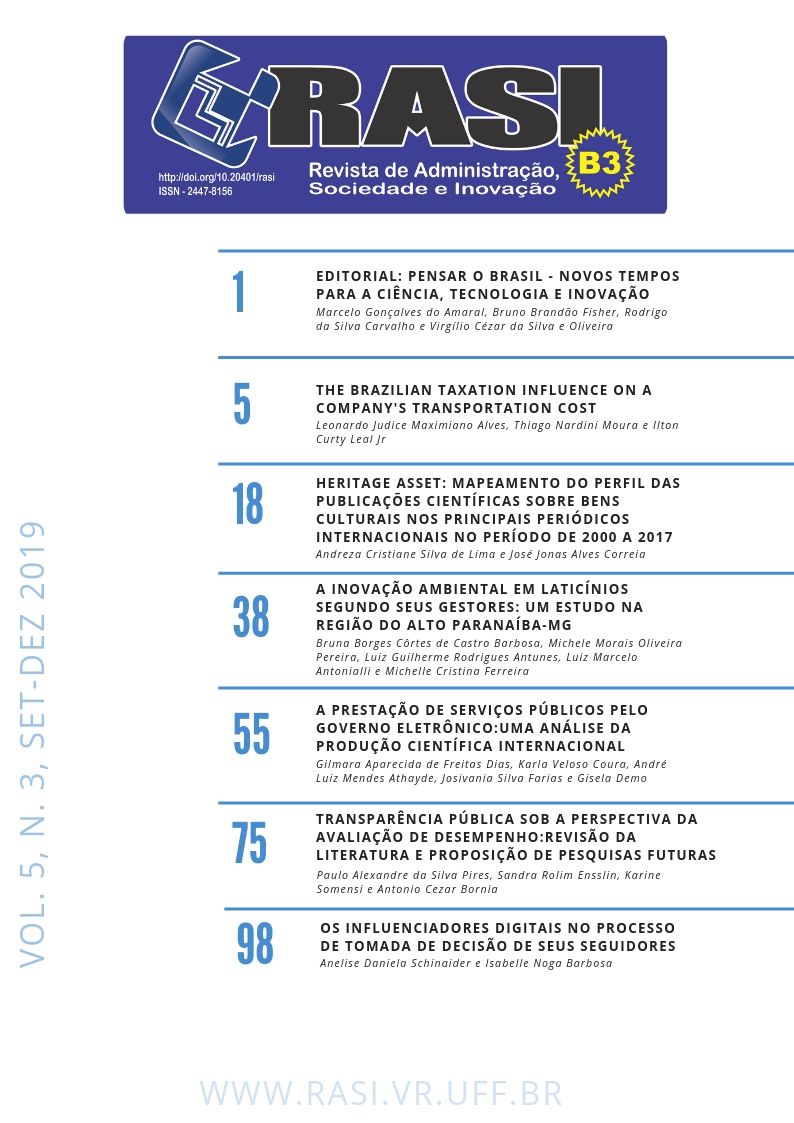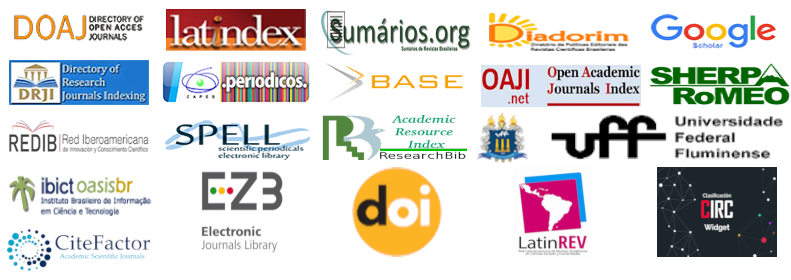A Prestação de Serviços Públicos pelo Governo Eletrônico
Uma Análise da Produção Científica Internacional
DOI:
https://doi.org/10.20401/rasi.5.3.294Palavras-chave:
Governo Eletrônico. Entrega de serviços. Bibliometria. Agenda de Pesquisa.Resumo
A forma como o governo proporciona a entrega de serviços aos cidadãos tem sido influenciada pela modernização das Tecnologias de Informação e Comunicação (TIC’s) e pelo uso da internet, o que vem gerando acesso facilitado por meio do governo eletrônico (e-gov). Desse modo, este trabalho tem como objetivo analisar o perfil da produção científica internacional sobre a entrega de serviços públicos pelo governo eletrônico. Para tanto, buscou-se identificar nos artigos os elementos demográficos, explorando os objetivos, resumos e palavras-chave e verificando estatísticas textuais, especificidades de grupos, classificação hierárquica descendente e nuvens de palavras no corpus textual, composto por 21 artigos extraídos da base de dados do Science Direct Proquest. Como métodos de análise, foram utilizadas a bibliometria, a sociometria, por meio da aplicação do software Iramuteq, a classificação hierárquica descendente (CHD) e a análise fatorial de correspondência (AFC). Em linhas gerais, os resultados retrataram que a temática mais publicada refere-se à adoção de tecnologia seguida pela implementação do e-gov. A análise realizada desvelou os itinerários da produção científica internacional no tema e subsidiou a proposição de uma agenda de pesquisa para estudos ulteriores.
Downloads
Referências
Akinboade, O. A., Mokwena, M. P., & Kinfack, E. C. (2013). Understanding citizens'participation in service delivery protests in South Africa's Sedibeng district municipality. International Journal of Social Economics, 40(5), 458 – 478. URL: https://www.emeraldinsight.com/doi/abs/10.1108/03068291311315331
Alomari, M., Woods, P., & Sandhu, K. (2012). Predictors for e-government adoption in Jordan. Information Technology & People, 25(2), 207 – 234. URL: https://www.emeraldinsight.com/doi/abs/10.1108/09593841211232712
Araújo, R. F., Alvarenga, L. (2011). A bibliometria na pesquisa científica da pós-graduação brasileira de 1987 a 2007. Revista Eletrônica de Biblioteconomia, 16(31), 51-70. URL: https://periodicos.ufsc.br/index.php/eb/article/view/1518-2924.2011v16n31p51/17757
Ask, A., Hatakka, M., & Gronlund, A. (2008). The Orebro City citizen-oriented e-government strategy. International Journal of Electronic Government Research, 4(4), 69 – 88. URL: http://www.irma-international.org/viewtitle/21491/
Barbosa, A.F., Pozzebon, M., & Diniz, E. H. (2013). Rethinking e-government performance assessment from a citizen perspective. Public Administration, 91(3), 744 – 762. URL: https://pesquisa-eaesp.fgv.br/sites/gvpesquisa.fgv.br/files/arquivos/pozzebon_-_rethinking_e-government_performanceassessment_from_a_citizen_perspective.pdf
Bardin, L. (1977). Análise de Conteúdo. Lisboa: Edições 70.
Billestrup, J., Born, N., Bruun, A., & Stage, J. (2016). Usability problems found across public self-service applications and self-service providers. Paper presented at the Proceedings of the 28th Australian Conference on Computer-Human Interaction, Launceston, Tasmania, Australia.
Brown, M. M., & Brudney, J. L. (2004). Achieving advanced electronic government services: Opposing environmental constraints. Public Performance & Management Review, 28(1), 96 – 113. URL: https://www.tandfonline.com/doi/abs/10.1080/15309576.2004.11051819
Camargo, B. V. (2005). ALCESTE: Um programa informático de análise quantitativa de dados textuais. In A. S. P. Moreira, B. V. Camargo, J. C. Jesuíno, & S. M. Nóbrega (Eds.), Perspectivas teórico-metodológicas em representações sociais (pp. 511-539). João Pessoa, PB: Editora da Universidade Federal da Paraíba.
Chan, F.K.Y, Thong, J.Y.L, Venkatesh, V., Brown, S. A., Hu, P. J. H., & Tam, K. Y. (2010). Modeling citizen satisfaction with mandatory adoption of an e-government technology. Journal of the Association for Information Systems, 11(10), 519 – 549. URL: https://aisel.aisnet.org/cgi/viewcontent.cgi?referer=https://www.google.com/&httpsredir=1&article=1549&context=jais
Coursey, D., & Norris, D. F. (2008). Models of e?government: Are they correct? An empirical assessment. Public administration review, 68(3), 523-536. URL: https://pdfs.semanticscholar.org/0f5b/85d312b03d0a0bf433f1ca3b83b750417e1b.pdf
Criado, J. I., & Ramilo, M. C. (2003). E-government in practice An analysis of Web site orientation to the citizens in Spanish municipalities. The International Journal of Public Sector Management, 16(3), 191-2018. URL: https://www.emeraldinsight.com/doi/abs/10.1108/09513550310472320
Davis F. D., & Venkatesh V. (1996). A critical assessment of potential measurement biases in the technology acceptance model: Three experiments. Internat. J. Human-Comput. Stud., 45(1), 19 – 45. URL: https://www.sciencedirect.com/science/article/abs/pii/S1071581996900403
Farias, J. S., & Borges, D. M. (2012). Fatores Que Influenciam a Aceitação de Tecnologia: a Percepção de Gestores e Funcionários em uma Rede de Restaurantes. Revista Gestão & Tecnologia, 12(2), 141 – 167. URL: http://revistagt.fpl.edu.br/get/article/viewFile/401/432
Gallouj, F., & Weinstein, O. (1997). Innovation in services. Research Policy, 26(4-5), 537-556. URL: https://halshs.archives-ouvertes.fr/halshs-01133098/document
Guedes, V. L. S., & Borschiver, S. (2005). Bibliometria: uma ferramenta estatística para a gestão da informação e do conhecimento, em sistemas de informação, de comunicação e de avaliação científica e tecnológica. Encontro Nacional de Ciência da Informação, 6, 1 – 18. URL: http://www.cinform-anteriores.ufba.br/vi_anais/docs/VaniaLSGuedes.pdf
Guri-Rosenblit, S. (2005). Distance education and e-learning: Not the same thing. Higher Education, 49(4), 467 – 493. URL: https://www.researchgate.net/publication/226829906_'Distance_education'_and_'e-learning'_Not_the_same_thing
Janita, M. S., & Miranda, F. J. (2018). Quality in e-Government services: A proposal of dimensions from the perspective of public sector employees. Telematics and Informatics, 35(2), 457-469. URL: https://www.sciencedirect.com/science/article/abs/pii/S073658531730881X
Kai, E. (2012). Self?Service Society: Participative Politics and New Forms of Governance. Public Administration, 90(3), 685-698. URL: https://onlinelibrary.wiley.com/doi/abs/10.1111/j.1467-9299.2011.01996.x
Kai, E., & Vogt, H. (2013). On self-service democracy:Configurations of individualizing governance and self-directed citizenship. European Journal of Social Theory, 16(2), 153-173. URL: https://journals.sagepub.com/doi/abs/10.1177/1368431012459693?journalCode=esta
Keramati, A., Behmanesh, I., & Noori, H. (2018). Assessing the impact of readiness factors on e-government outcomes:An empirical investigation. Information Development, 34(3), 222-241. URL: https://journals.sagepub.com/doi/abs/10.1177/0266666916685603
Kronberger, N. E., & Wagner, W. (2002). Palavras-chave em contexto: análise estatística de textos. In: M.W. Bauer & G. Gaskell (Orgs.). Pesquisa qualitativa com texto, imagem e som: um manual prático. Petrópolis: Vozes.
Löffler, E. (2009). Why co-production is an important topic for local government. Governance International. URL: http://www.govint.org/fileadmin/user_upload/publications/coproduction_why_it_is_important.pdf
Meijer, A. (2011). Networked Co-Production of Public Services in Virtual Communities: From a Government-Centric to a Community Approach to Public Service Support. Public Administration Review, 71 (4), 598 – 607. URL: https://onlinelibrary.wiley.com/doi/abs/10.1111/j.1540-6210.2011.02391.x
Moon, M. J. (2002). The Evolution of E-Government among Municipalities: Rhetoric or Reality. Public Administration Review, 62(4), 424 – 433. URL: https://www.jstor.org/stable/3110357?seq=1#page_scan_tab_contents
Naoum, R., & Nadhim, Z. (2014). An Enhanced Model for E-Government: A Comparative Study between Jordanian and Iraqi Citizens. International Journal of Advanced Computer Research, 4, 11 – 18. URL: https://pdfs.semanticscholar.org/01a6/502813aa46c9eeaa6d7d0ff822243c027b59.pdf
Osborne, S. P., Radnor, Z., & Nasi, G. (2012). A New Theory for Public Service Management? Toward a (Public) Service-Dominant Approach. The American Review of Public Administration, 43(2), 135-158. URL: https://journals.sagepub.com/doi/abs/10.1177/0275074012466935?journalCode=arpb
Pereira, G. V., Rinnerbauer, B., Ginner, M., & Parycek, P. (2017). Categorizing Obstacles in e-Government: Formal and Informal. Paper presented at the Proceedings of the 10th International Conference on Theory and Practice of Electronic Governance, New Delhi AA, India.
Pestoff, V. (2006). Citizens and co-production of welfare services. Public Management Review, 8(4), 503-519. URL: https://www.researchgate.net/publication/247517818_Citizens_and_Co-production_of_Welfare_Services
Previtali, P., & Bof, F. (2009). E?government adoption in small Italian municipalities. International Journal of Public Sector Management, 22 (4), 338 – 348. URL: https://www.emeraldinsight.com/doi/abs/10.1108/09513550910961619?journalCode=ijpsm
Ramírez-Correa, P. E., Arenas-Gaitán, J., & Rondán-Cataluña, F. J. (2015). Gender and Acceptance of E-Learning: A Multi-Group Analysis Based on a Structural Equation Model among College Students in Chile and Spain. PLOS ONE, 10(10), 1 – 17. URL: https://journals.plos.org/plosone/article?id=10.1371/journal.pone.0140460
Ramos-Rodríguez, A., & Ruíz-Navarro, J. (2004). Changes in the Intellectual Structure of Strategic Management Research: A Bibliometric Study of the Strategic Management Journal, 1980-2000. Strategic Management Journal, 25(10), 981 – 1004. URL: https://onlinelibrary.wiley.com/doi/abs/10.1002/smj.397
Ranaweera, H. M. B. P. (2016). Perspective of trust towards e-government initiatives in Sri Lanka. SpringerPlus, 5(1), 22. URL: https://www.researchgate.net/publication/289586401_Perspective_of_trust_towards_e-government_initiatives_in_Sri_Lanka
Roy, J. (2017). Digital government and service delivery: An examination of performance and prospects. Canadian Public Administration, 60(4), 538-561. URL: https://onlinelibrary.wiley.com/doi/full/10.1111/capa.12231
Sadik, H. (2015). A Perception study on public response to E-service delivery in Bangladesh. Information Studies, 21(2), 151 – 166. URL: http://www.academia.edu/19577595/A_Perception_Study_on_Public_Response_to_E-service_Delivery_in_Bangladesh
Scott, J. K. (2005). E-Services: Assessing the Quality of Municipal Government Web Sites. State and Local Government Review, 37(2), 151 – 165. URL: https://www.jstor.org/stable/4355397?seq=1#page_scan_tab_contents
Sun, P., Ku, C., & Shih, D. (2015). An implementation framework for E-Government 2.0. Telematics and Informatics, 32(3), 504-520. URL: https://www.sciencedirect.com/science/article/abs/pii/S0736585314000926
Tesu, M. (2012). Developing e-government for better public services within European union. Theoretical and Empirical Researches in Urban Management, 7(2), 79 – 88. URL: https://ideas.repec.org/a/rom/terumm/v7y2012i2p79-89.html
Tolbert, C. J., & Mossberger, K. (2006). The Effects of E-Government on Trust and Confidence in Government. Public Administration Review, 66(3), 354 – 369. URL: https://onlinelibrary.wiley.com/doi/abs/10.1111/j.1540-6210.2006.00594.x
Vassilakis, C., Lepouras, G., Fraser, J., Haston, S., & Georgiadis, P. (2005). Barriers to electronic service development. E?Service Journal, 4(1), 41 – 63. URL: https://muse.jhu.edu/article/194042
West, D. M. (2004). E-government and the transformation of service delivery and citizen attitudes. Public Administration Review, 64(1), 15 – 27. URL: https://pdfs.semanticscholar.org/b302/18d3305a80dd0fd799961b5f4f892ef02ada.pdf
Downloads
Publicado
Edição
Seção
Licença
A RASI, de acordo com a Lei nº 9.610, de 19.02.98 que altera, atualiza e consolida a legislação sobre direitos autorais e dá outras providências, adota as seguintes condições da Cessão de Direitos Autorais:
- A Revista de Administração Sociedade e Inovação (RASI) mantém, com a cessão dos direitos autorais, a posse dos direitos sobre os conteúdos por ela publicados;
- O autor retém seus direitos morais do conteúdo, incluindo o direito de ser identificado como autor sempre que o conteúdo for publicado;
- Apesar da atribuição dos direitos autorais o autor retém o direito de reutilizar o material em coleções futuras de seu próprio trabalho sem ônus. Os reconhecimentos da publicação anterior na RASI são as únicas exigências em tais casos;
- O autor pode fazer fotocópias do conteúdo, ou distribuí-lo por meio de correio eletrônico ou fax, desde que destinadas às suas próprias aulas e com finalidade de atender objetivos de pesquisa, sob a condição de que: (a) tais cópias não sejam revendidas e (b) referência a fonte original da publicação e o nome da RASI estejam indicados claramente em todas as cópias feitas do material.











